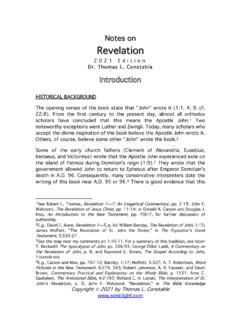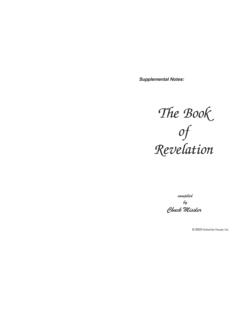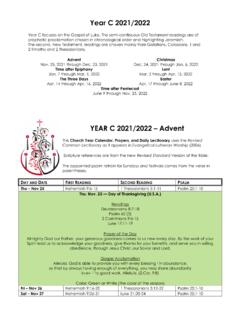Transcription of Dei Verbum: The Dogmatic Constitution on Divine Revelation
1 Dei Verbum: The Dogmatic Constitution on Divine Revelation 1. Historical Context The document Dei Verbum (Word of God) is one of only two Dogmatic constitutions issued by the Second Vatican Council, the other being Lumen Gentium, the Dogmatic Constitution on the Church. As such Dei Verbum (henceforth DV) is one of the most authoritative and important documents of the Council. Its purpose is to spell out the Church s understanding of the nature of Revelation , that is, the process whereby God communicates with human beings. As such it touches on questions about Scripture, tradition and the teaching authority of the Church. The remote context of this document is the emergence of historical consciousness in the 18th and 19th centuries and the impact that this had on the understanding of the Scriptures.
2 Historians began to adopt new more historical ways of reading the Bible, and this had flow-on effects into the whole understanding of both the Bible and Church tradition. At the end of the 19th century a movement arose, called Modernism, which sought to accommodate the Church to some of these new understandings. While this movement went too far in seeking to relativise tradition and Church authority and was thus condemned by the Church, the impact of historical consciousness itself could not be suppressed. In his ground-breaking encyclical Divino Afflante Spiritu (1943), Pius XII gave permission to Catholic scripture scholars to adopt new ways of reading the scriptures which were more congruent with these new historical methods. Nonetheless there remained general suspicion about these methods, and those scholars which adopted them continued to suffer from accusations and recriminations.
3 The work of the Second Vatican Council brought new developments. With the calling of the Council it was clear that any document on the topic of Revelation would be the place where this battle would be fought out. As was the accepted process a preparatory commission, under the direction of Cardinal Ottaviani, put together a draft document which was meant to form the starting point for the discussions of the Council. This first draft was largely shaped by debates going back to the Reformation, and spoke of two sources of Revelation , Scripture and Tradition. Further it continued to treat the Bible in an unhistorical manner, not in the manner congruent with historically conscious approaches. Finally it contained various condemnations and warnings which were not in line with the more pastoral approach desired by Pope John XXIII.
4 Although this draft was opposed by the majority of the bishops, the vote did not achieve the two-thirds majority needed to reject it altogether. At this point Pope John personally intervened and had the document withdrawn and completely redrafted. This action of Pope John represented a major shift in the processes of the Council. It lessened the power of the preparatory commissions which were dominated by theologians who were unfamiliar with and suspicious of the type of historical methodologies which were being introduced into the study of theology. It gave the bishops more room to move in relation to other preparatory documents which reflected similar limitations. In its final form, promulgated by Pope Paul VI on 18 November 1965, Dei Verbum continues the trajectory initiated by Divino Afflante Spiritu, allowing Catholic scripture scholars to read the Bible as arising within particular social and cultural contexts.
5 It places this insight, however, 1within a larger framework of Divine Revelation and the role of the Church s teaching authority. As such it needs to be read in the context of Lumen Gentium (LG), the Dogmatic Constitution on the Church, particularly those parts on the teaching authority of the Church. 22. Overview of the document After a brief prologue, the document has six major chapters: 1. Divine Revelation Itself 2. The Transmission of Divine Revelation 3. Sacred Scripture: Its Divine Inspiration and Its Interpretation 4. The Old Testament 5. The New Testament 6. Sacred Scripture in the Life of the Church As is clear from this structure, the major concern of the document is to proclaim a Catholic understanding of the Bible as the word of God . This understanding is placed within the larger context of the Church s understanding of Revelation itself.
6 Here the document speaks not of Revelation about God, but the Revelation of God It pleased God in his goodness and wisdom to reveal himself and to make known the mystery of his will ( , see also )). Theologians will pick up this theme and speak of Revelation as Divine self-communication , that is, God communicates his very self to us, making us sharers in the Divine nature ( ). The document places Revelation in the context of God s saving will operating in history, or salvation history . Both the inner Word of God, incarnate in jesus christ , and the Holy Spirit play a role in Revelation , which thus has a Trinitarian structure. These are all significant theological advances on previous Church documents. The second chapter deals with the relationship between Scripture and Tradition in the context of the transmission of Revelation within the Church.
7 The role of the apostles and their successors the bishops is highlighted. Most significant here is the close relationship that the document identifies between Scripture and Tradition. Rather than positing two sources of Revelation , as had earlier been the case, it speaks of one Divine wellspring ( ) making up a single deposit of faith entrusted to the Church ( ). The authentic interpretation of the word of God is entrusted to the teaching office of the Church, which is not above the word of God, but serves it ( ). The third chapter contains the basic principles whereby Catholic scripture scholars should approach the Bible. Thus it continues the teaching of Divino Afflante Spiritu by encouraging scholars to read the Bible within its historical context. While it is true that God speaks through the Bible, the human authors remain true authors , not just secretaries taking dictation from God.
8 God speaks through them in human fashion . So in order to understand the biblical text it is necessary to pay attention to the literary forms of the text, for example whether it is historical, or poetic or prophetic. We must understand the customary and characteristic patterns of perception, speech and narrative ( ) of the authors if we are not to misunderstand what the author intends to convey. The chapters on the Old and New Testament place these books within the history of salvation that lies at the core of these collections. For the Church the New Testament is hidden in the Old Testament, and the true meaning of the Old Testament is made manifest in the New Testament. A special place is held by the Gospels, with the Church maintaining their apostolic origin and historical intent.
9 Nonetheless, in line with modern historical approaches, the document recognises that the Gospels are not diaries of jesus life, but are mediated through the interests of the Church of the time ( ). 3 The final chapter places Scripture in the life of the Church. In a way that would have surprised many Catholics the Council taught that the Church has always venerated the Divine Scriptures just as she venerates the [eucharistic] Body of the Lord ( ). The document encouraged Catholics to read the Bible and in particular urged theologians and priests to become more thoroughly formed by the Bible. Quoting St Jerome, an early biblical scholar and translator of the Bible, it reminds us that ignorance of the Scriptures is ignorance of christ . 43. Key points and quotations from document Revelation has a Trinitarian structure and is manifest in history In His goodness and wisdom God chose to reveal Himself and to make known to us the hidden purpose of His will (see Eph.)
10 1:9) by which through christ , the Word made flesh, man might in the Holy Spirit have access to the Father and come to share in the Divine nature (see Eph. 2:18; 2 Peter 1:4).. This plan of Revelation is realized by deeds and words having an inner unity: the deeds wrought by God in the history of salvation manifest and confirm the teaching and realities signified by the words, while the words proclaim the deeds and clarify the mystery contained in them. By this Revelation then, the deepest truth about God and the salvation of man shines out for our sake in christ , who is both the mediator and the fullness of all Revelation . ( ) Revelation is a Divine self-communication Through Divine Revelation , God chose to show forth and communicate Himself and the eternal decisions of His will regarding the salvation of men.



